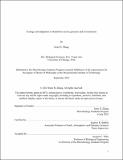Ecology and adaptation of denitrifiers across genomes and environments
Author(s)
Zhang, Irene H.
DownloadThesis PDF (40.75Mb)
Advisor
Babbin, Andrew R.
Terms of use
Metadata
Show full item recordAbstract
Although nitrogen comprises 78% of the Earth’s atmosphere, this N2 gas is largely inaccessible to most living organisms, limiting the supply of bioavailable (i.e. fixed) nitrogen to many marine, terrestrial, and aquatic environments. Microbes primarily mediate the many steps of the nitrogen cycle, including losses from anaerobic ammonia oxidation (anammox) and denitrification. The stepwise reduction of nitrate to nitrite, nitric oxide, nitrous oxide, and N2 gas, denitrification can be performed by diverse taxa and acts as a major sink of fixed nitrogen within low oxygen environments, and contribute to emissions of the greenhouse gas nitrous oxide. While canonical studies typically use model complete denitrifiers capable of fully reducing nitrate to N2 gas, sequencing efforts have revealed a diversity of partial denitrifiers capable of only one or a subset of denitrification steps in natural systems. Much remains to be known about the adaptive advantages of partial denitrification, the taxonomic identities and ecological roles of environmental partial denitrifiers, and the radiation of denitrification genes within and across environments. Using a combination of laboratory models, metagenomics, and phylogenetics approaches, we find a predominance of partial denitrifiers within marine oxygen deficient zones, uncover evidence for a rate vs. yield tradeoff between complete and partial denitrifiers, explore the metabolic capabilities of uncultivated putative denitrifiers, and investigate the diversification of denitrifying lineages and genes in a range of natural environments.
Date issued
2023-09Department
Massachusetts Institute of Technology. Microbiology Graduate ProgramPublisher
Massachusetts Institute of Technology